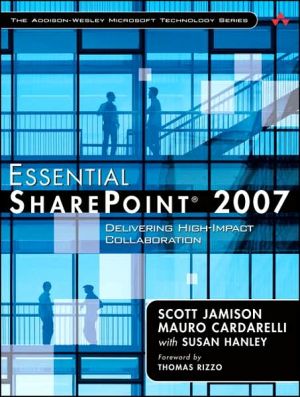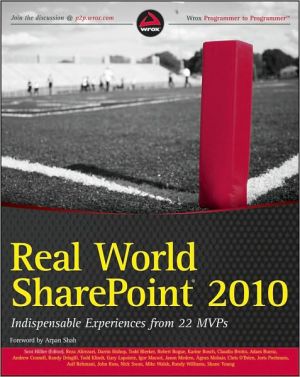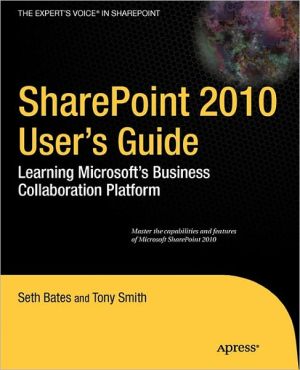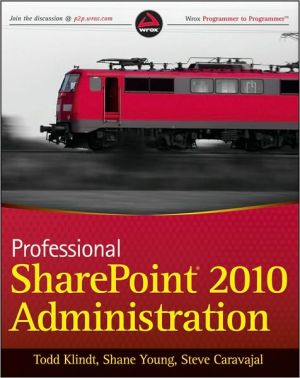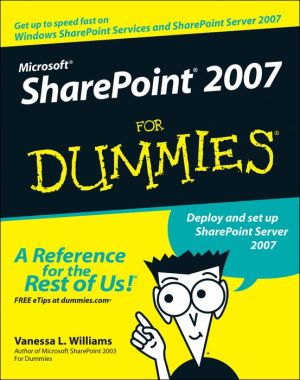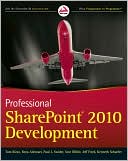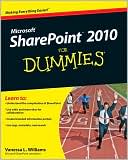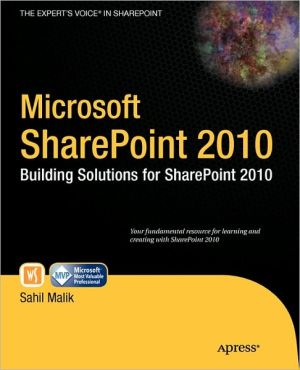Essential SharePoint 2007: Delivering High-Impact Collaboration Solutions (The Addison-Wesley Microsoft Technology Series)
Essential SharePoint® 2007 focuses on utilizing Microsoft Office SharePoint 2007 to improve collaboration and decision-making, streamline processes, and solve real-world business problems. Three leading SharePoint consultants systematically address the crucial success factors, intangibles, and "gotchas" in SharePoint deployment–showing exactly how to maximize business value and reduce project risk.\ Drawing on their unsurpassed experience, the authors walk you through planning and...
Search in google:
Essential SharePoint® 2007 focuses on utilizing Microsoft Office SharePoint 2007 to improve collaboration and decision-making, streamline processes, and solve real-world business problems. Three leading SharePoint consultants systematically address the crucial success factors, intangibles, and "gotchas" in SharePoint deployment–showing exactly how to maximize business value and reduce project risk.Drawing on their unsurpassed experience, the authors walk you through planning and architecting successful SharePoint solutions around the unique needs of your business. Next, they address the operational support and end-user functionality needed to make SharePoint 2007 work–with special attention given to the organizational and political issues that can make or break your project. Learn how to: Define optimal, workable collaboration strategies Build SharePoint applications people want to use Architect SharePoint infrastructure for superior performance, reliability, and value. Provide your customers with state-of-the-art sites, blogs, and wikis Use SharePoint content management to integrate documents, records, and Web content, and make it all searchable Implement forms-based workflow to optimize virtually any business process Quickly build business intelligence solutions using Web-base dashboards and server-based Excel Services Organize and staff SharePoint support teams Migrate efficiently from SharePoint 2003Whether you're a project manager, consultant, analyst, line-of-business executive, or developer, this book helps you align your SharePoint project with your business strategy–and deliver quantifiable results fast.PrefaceChapter 1 Your Collaboration Strategy: Ensuring SuccessChapter 2 Office SharePoint Server 2007: High-Impact CollaborationAcross the Extended EnterpriseChapter 3 Introduction to the 2007 Office System as a Collaborationand Solutions PlatformChapter 4 SharePoint Architecture FundamentalsChapter 5 Planning Your Information ArchitectureChapter 6 Planning Your Move from SharePoint 2003 to 2007:Upgrade or Rebuild?Chapter 7 Disaster Recovery PlanningChapter 9 Enterprise Content Management: Documents,Records, and WebChapter 10 Enterprise SearchChapter 11 Making Business Processes Work: Workflow and FormsChapter 12 Office 2007: Offline Options for MOSS 2007Chapter 13 Providing Business IntelligenceAppendix A SharePoint User TasksAppendix B OS/Browser/Office CompatibilityIndex
PrefacePreface\ Collaboration. Portals. Knowledge Management. Search. Document Management. These are terms that are thrown around when talking about Microsoft Office SharePoint Server 2007 (MOSS). But what do they really mean?\ Most books are designed to address the "how" behind SharePoint, either from an administrative perspective or a programming perspective. This book complements the typical SharePoint book with some of the "what" and "why" of MOSS, provides insight into targeting needs with portal and collaboration technologies, and helps you understand how those needs might be addressed using MOSS.\ What Is This Book About?\ The Information Worker is central to Microsoft's strategy to bring productive computing to the enterprise and beyond. Navigating the various client and server products can be confusing and daunting. This book will help you navigate these waters, providing direction and understanding.\ Specifically, this is a book about Microsoft's SharePoint platform, with a particular focus on three commonly requested topics: end-user features, proper collaboration strategy, and a business-focused discussion on how to apply SharePoint's key features. This book was written because collaboration, knowledge and content management, and Web accessibility are three of the most sought-after features in a corporate software solution. The key product that is the basis for most Microsoft-based solutions in this area is Office SharePoint Server. Because of this functionality, SharePoint is perhaps one of the most important server products that runs on Windows Server. If you want to deploy SharePoint in your enterprise, upgrade from previous versions, or need a concise introduction regarding collaboration solutions with SharePoint, you're starting in the right place. This book provides a great user-level guide to Microsoft's latest version of SharePoint, along with usage strategies and some insight regarding the technologies involved. This book is intended to be a tutorial as well as a handy reference.\ This book does not cover methodology or process, nor does it provide a one-size-fits-all approach to building applications. A central thrust of this book is a handy introduction to the feature set, deployment, and customization approaches that are available for SharePoint. But we also get into the why of using SharePointmdwhat is the business need and does it get addressed? Because SharePoint supports a number of approaches and techniques, you'll want to get familiar with the choices (for example, "Do I go with a teamsite, a blog, or a wiki?") before making a decision on an approach that fits your specific needs. This book helps you do just that.\ What You Will Learn From This Book\ To implement a collaborative system effectively, you'll likely need to consider a number of key questions:\ \ Do I need a portal or collaboration strategy? If so, how do I create one?\ How do users perform the top activities that they'll need to do?\ What do I need to consider when I upgrade from previous versions of SharePoint?\ Where are documents stored currently? Where should documents live?\ How do users collaborate today?\ What kind of hardware do I need? How do I deploy the product properly?\ How does the Web fit into my collaboration needs? What about Office and smart client applications? How about Groove, InfoPath, and Access?\ Will I share information outside of my organization? Should I?\ \ Who Should Read This Book\ If you're a developer, you probably already own a SharePoint programming book or MOSS API guide (or are looking for one). This is not a book about SharePoint programming. However, developers will find this book useful when building solutions (in conjunction with an API guide) because there are important business considerations that are critically important to every MOSS-based solution.\ If you're a project manager, consultant, or business analyst, you'll find that this book helps with all of the intangibles of a MOSS rollout. For example, "What roles should exist to support MOSS?" or "What should my offline/search/business data strategy be for MOSS?" This book also introduces you to some key technical concepts and provides simple walkthroughs of the key features that many businesses need to leverage.\ How This Book Is Organized\ This book is organized into four key sections:\ \ The first section, chapters 1 and 2, helps you determine what kinds of business needs are addressed by portals, collaboration solutions, and knowledge management systems and how you should think about SharePoint-based solutions within your organization.\ The second section, chapters 3 and 4, are a great introduction to the MOSS feature set and architecture.\ The third section, chapters 57, helps you evaluate and plan your information architecture, upgrade strategy, and disaster discovery needs.\ The forth section, chapters 813, provides great information on specific MOSS feature sets along with guidance, recommendations, and examples.\ \ Appendix A provides a list of the top SharePoint user tasks, while Appedix B provides a summary of how SharePoint behaves with various operating system,browser, and Office versions.\ Key Points\ At each chapter's conclusion is a section called Key Points, which summarizes the key facts, best practices, and other items that were covered within the chapter.\ Thank You\ Thank you for reading this book. Our goal was to write the most concise yet useful business-centric guide to Microsoft Office SharePoint Server 2007. Enjoy!\ © Copyright Pearson Education. All rights reserved.
Preface . . . . . . . . . . . . . . . . . . . . . . . . . . . . . . . . . . . . . . . . . . . . . . . . . . . . . . . . . . . . . .xviChapter 1 Your Collaboration Strategy: Ensuring Success . . . . . . . . .1Chapter 2 Office SharePoint Server 2007: High-Impact CollaborationAcross the Extended Enterprise . . . . . . . . . . . . . . . . . . .35Chapter 3 Introduction to the 2007 Office System as a Collaborationand Solutions Platform . . . . . . . . . . . . . . . . . . . . . . . . .57Chapter 4 SharePoint Architecture Fundamentals . . . . . . . . . . . . . .99Chapter 5 Planning Your Information Architecture . . . . . . . . . . . .123Chapter 6 Planning Your Move from SharePoint 2003 to 2007:Upgrade or Rebuild? . . . . . . . . . . . . . . . . . . . . . . . . . .139Chapter 7 Disaster Recovery Planning . . . . . . . . . . . . . . . . . . . . .155Chapter 9 Enterprise Content Management: Documents,Records, and Web . . . . . . . . . . . . . . . . . . . . . . . . . . . .207Chapter 10 Enterprise Search . . . . . . . . . . . . . . . . . . . . . . . . . . . . .247Chapter 11 Making Business Processes Work: Workflow and Forms . . . . . . . . . . . . . . . . . . . . . . . . . .287Chapter 12 Office 2007: Offline Options for MOSS 2007 . . . . . . . .329Chapter 13 Providing Business Intelligence . . . . . . . . . . . . . . . . . . .349Appendix A SharePoint User Tasks . . . . . . . . . . . . . . . . . . . . . . . . .379Appendix B OS/Browser/Office Compatibility . . . . . . . . . . . . .PDF:425Index . . . . . . . . . . . . . . . . . . . . . . . . . . . . . . . . . . . . . .435
